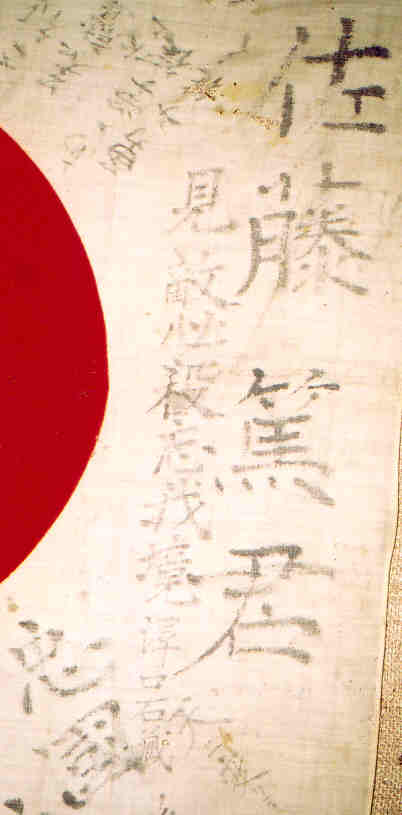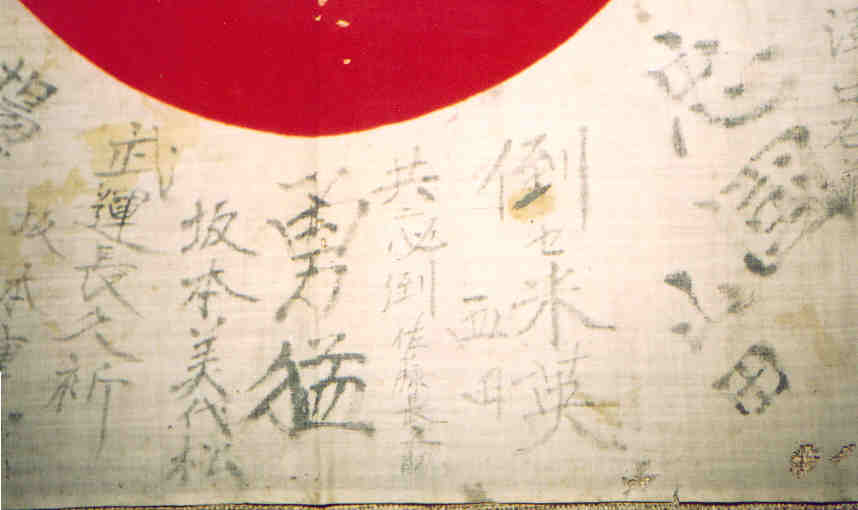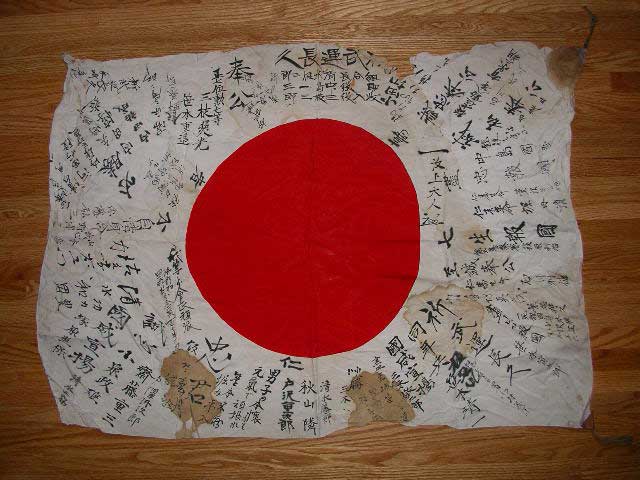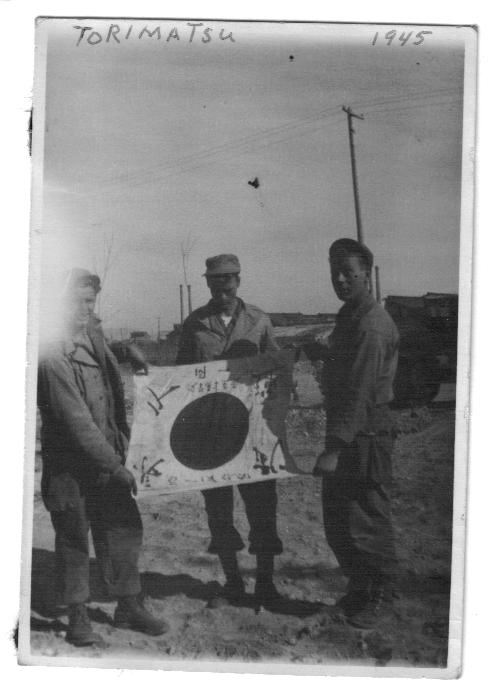Nambu
World: Japanese Good Luck Flags

Japanese
soldiers often carried a couple of mementoes to bring them good luck. One was
the famous senninbari, or gthousand
stitch belth, covered in a separate section. The other, perhaps more common,
was an autographed hinomaru flag.
These were called hinomaru yosegaki,
or grising sun autographsh in Japanese. I have three
of these. The first one I acquired is shown above, and the other are further down this page. I also have one banner
celebrating a young manfs entry into the service; it is described at the bottom
of the page.
Hinomaru
literally means gcircular sunh; this design is often called a gmeatballh flag
by American collectors to distinguish it from the Army and Navy flags with rays
emanating from the sun. Here is a paragraph from page 261 of Mike Hewittfs book,
Uniforms and Equipment of the Imperial
Japanese Army in World War II that describes the practices associated with
these flags:
gWhen
new recruits or reservists were called to active duty almost invariably either
their family members or company purchased a Japanese flag and had the recruitfs
relatives or friends and co-workers sign their names and a good luck or
patriotic message to the flag. Throughout the war the soldier carried these
flags, close to the bodyh (there are related photos on pages 272-274 of this
outstanding book, which is packed with amazing colour photos of artifacts as
well as period photos in black and white of the items in use).
The
flag would be carried in the soldierfs pocket for luck. It could also come in
handy to signal his position. This flag is about 25h X 34h, or 64cm by 86cm,
although it is hard to get an exact measurement due to the wrinkles. Consistent
with having been carried in a soldierfs pocket for a long time, it has a
several small holes, especially along the top, lots of wrinkles and some stains
(a couple could be blood stains and surround a hole that is the right size to
be a bullet hole; look at the middle of the upper edge). The material is either
silk or a similar synthetic and has reinforcements of a stiffer, brown material
on the right corners with woven ties. These flags usually had a patriotic
slogan of some kind written across the top and the soldierfs name written
vertically along the right side. On this flag the four large characters across
the top read from right to left: jinchu
hokoku, which means gloyalty and national serviceh (hokoku can also be translated as gpatriotismh, but there is another
word for that, aikoku, which means
literally glove of countryh). The soldierfs name along the right side is a very
unusual name. It is not listed in my dictionary of names, but the first
character (top right) is probably not part of the name itself, but rather gtameh, meaning gfor, on behalf ofh. The
family name (written first, the next two characters along the right side), is
probably gKameuchih (the characters
mean literally gturtleh and gwithinh). The given name (the next two characters)
is also not listed, but is probably gTatsuichih.
These characters mean literally gthe dragonh, the fifth sign of the Oriental zodiac,
and goneh. The last character on the bottom is gkunh, which means gMr.h when referring to a young man. The rest of
the writing is just names. Given names are hard to transliterate, but the
family names are mostly fairly easy providing the handwriting is clear (as with
English handwriting, Japanese handwriting is sometimes almost illegible). This
list starts in the lower right and goes clockwise to the upper left corner. I
have used g?h to take the place of the names I have to research or examine more
and g?h in brackets to indicate uncertainty about a name. Here are the family
names of those who signed:
Nagase,
Watanabe, Takahashi, ?, ?, Matsumura, ?, Matsuoka, Yamamoto, Sakai, Kindo, ?,
Murata, ?, Miyata, Sakai (the larger, vertical characters in the lower left),
Usui, Kato, ?, Morishita, Kawamatsu, Terada, (two written diagonally in the
left corner I canft read), Kojima, Komuro, Shimada, Hasegawa, Kajita, Nakizawa,
Uesugi, Nebashi(?), Taki(?), Hane(?), (?)-zawa, Yamada (last two are written
parallel to left edge), ?, Shirotano, Takahara, Kindo,
Komi, Suzuki, Kato,
In
several spots there are mirror images of the writing from the ink weeping. In
the upper right corner, for example, the faint writing is actually the mirror
image of the writing on the opposite side, indicating the flag was folded right
to left first. I bought this flag on eBay together with the Japanese currency
shown below. Both the flag and currency were reportedly gbrought back from
The
second flag I have is a little different. It is almost square (30.5h wide by
29.5h high, or 77cm X 75cm) and is made out of very thin cotton with real
leather corner tabs. It has more slogans on it than names. Here it is.

The
main slogan across the top is read from right to left: shuku-nyu-tai, or gCongratulations on your enlistmenth. The big characters down the right side
are read from top to bottom and say Sato
Atsushi-kun, or gMr. Atsushi Satoh. The slogans radiate out from the
central red circle like rays of the sun. A few have names indicating who added
them, but most donft. Herefs a close-up of the right side. To the left of the
manfs name in another slogan written top to bottom and signed by a Mr.
Sawaguchi. The slogan reads: ken-teki-his-satsu-bo-ga-kyo,
or g[achieve] a state where upon seeing the enemy, without thinking you
certainly kill himh. In the lower left of the photo is another slogan comprised
of two characters, chu-koku, or
gloyalty to the countryh.

This
is a close-up of the bottom. In the upper right corner of this photo you can
see the two characters that were in the lower left of the first picture, along
with the family name of the person who wrote them: Yamada. Those two columns
are written at an angle. The first more or less perpendicular column says tao-se bei-ei, or gdefeat

Since
this flag has so many slogans on it, I will eventually type out a little
glossary showing each slogan in Japanese and its pronunciation and translation
for those who have other flags. It will probably cover most of the common
slogans likely to be found on these flags.
Here
is the third flag, which I bought in August, 2004. It is about 40h (100cm) wide
and 28h (69cm) high, seems to be made of silk and has leather tabs on the right
corners. The stains do not look like blood: blood separates and usually has an
outer, lighter ring around the dark area. This seems more like mud stains or
something that has leached out of wood. The reason I wanted this one is that
someone had sent me a scan of a photo of a Japanese soldier holding a flag with
a a slogan on it that I hadnft seen before, and then right afterwards I saw
this flag with the same slogan. It is at 3 ofclock and says shchi-sho-ho-koku, gseven lives of
national serviceh. I am going to do some research and see whether I can find
out what the significance of this phrase is. Another interesting one is over in
the lower left corner: koku-i sen-yo. It means genhance national prestigeh,
and is also found repeated at about 5 ofclock. I have seen a couple of flags
with variations on this gnational prestigeh idea. Up at the top written right
to left starting at the big tear is the common inori-bu-un-cho-kyu, gwe pray for eternal good luck in warh. About
4 ofclock is the same slogan repeated. Just a little counter-clockwise is
another common slogan, jin-chu-ho-koku,
gloyalty and national serviceh (ho-koku
can also be translated as gpatriotismh).

The
soldierfs name is not as prominent as on most flags. It seems to be around 7
ofclock and is simply Tadashi-kun.
This is unusual since Tadashi is a
given name. Kun, meaning gMr.h when
applied to a young man, can be applied to either a given name or surname, but
Japanese are seldom called by their given names except by very close friends in
informal situations. There are several more slogans on this flag that I will
translate later. It seems to be about 50% slogans and 50% names.
These
autographed flags were very popular souvenirs among US servicemen in the
Pacific. One often sees group photos of them holding up such flags, often
backwards or upside down because, of course, very few could read the Japanese
writing. This photo was sent to me by the son of a

To return
to gOther Japanese Militariah, please click here: Nambu World: Other
Japanese Militaria
To return
to the home page, please click here: Nambu World: Terifs WWII Japanese
Handgun Website
Last updated: July 25, 2006. All contents are
copyright Teri unless otherwise specified and may not be used elsewhere in any
form without prior permission.